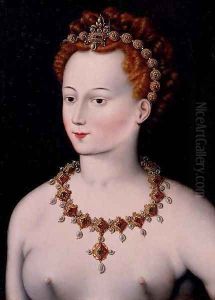School Of Fontainbleau Paintings
The School of Fontainebleau refers not to a single artist, but to a group of artists and the distinctive style that arose from the Fontainebleau Palace in France during the 16th century. The school was a center of Mannerist art in France and played a significant role in introducing Italian Renaissance ideas to France. The School of Fontainebleau was initiated by King Francis I of France, who, after being captivated by Italian art, invited several Italian artists to France to decorate his palace.
The first phase of the School of Fontainebleau, from about 1530 to the 1560s, was dominated by the work of the Italian painter and architect Rosso Fiorentino, who arrived at Fontainebleau in 1530, and the Italian artist Francesco Primaticcio, who arrived in 1532. Rosso Fiorentino's time at Fontainebleau was short-lived as he died in 1540, but his influence was significant. Primaticcio took over the leading role after Rosso's death and continued to work at Fontainebleau for the remainder of his life.
The artists at Fontainebleau were known for their sophisticated and elegant compositions, elongated figures, and a decorative style that was rich in ornamentation. This included stucco reliefs, frescoes, and oil paintings, many of which featured themes from classical mythology. The School also included other Italian artists like Niccolò dell'Abbate, who contributed to the palace's decoration.
The second School of Fontainebleau began in the 1590s and lasted until about 1610. This period included artists who were influenced by the first generation but also began to incorporate more French elements into their work. The second school's output is less well-documented and considered of lesser artistic significance compared to the pioneering work of the first generation.
The School of Fontainebleau had a far-reaching influence on French art and would eventually contribute to the development of the French Baroque style. It also influenced decorative arts, such as furniture design and the ornamental aspects of architecture. While the School of Fontainebleau itself faded by the early 17th century, its impact on the aesthetic tastes in France and across Europe continued for many years to come.
